Flexible Flooring: Comfort and Quality for Your Home
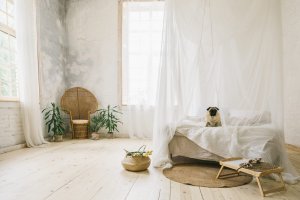
Some of the best aspects of flexible flooring include things like how it’s easy to install, cheap, and can often act as insulation and soundproofing.
But that’s not all. Many of the different types are also moisture resistant and easy to clean. This makes flexible flooring a great choice for places like the kitchen, bedroom, hallways, and anywhere else you spend a lot of time.
Flexible flooring: a safe bet
There are multiple degrees of flexibility within the world of flexible flooring. Textile-based flooring (mats and carpets) and cork are on the softer side. Then there are things like linoleum and vinyl flooring, which are more in the middle.
If you want to avoid spending too much money or want to remodel without having to tear the house apart, these types of flooring tend to be your best option.
They’re easy to install, and often come in rolls, sheets, or tiles. They’re also really easy to clean and maintain in general. In other words, they’re extremely practical and affordable. But best of all: they open up lots of decorative possibilities for you.
Now we’re going to show you some of the best types of flexible flooring. Pay attention, because we’re confident this will help you make a decision.
Carpet

Pleasant to walk on, carpet is very common in colder parts of the world because of its ability to insulate. Another big advantage of it is that it can muffle sounds.
People manufacture carpet out of natural materials like wool or synthetic ones like nylon. But keep in mind that the synthetic ones can often generate static.
As for its disadvantages, it has to be said that carpet flooring isn’t very moisture resistant. It also doesn’t last as long as other types of flexible flooring. You can expect to get about 5-7 years out of yours. The thicker the carpet, the longer it will last.
It’s super easy to install, and you can buy it in rolls or tiles. Carpet tiles are a bit harder to install, but the nice thing about them is that you can’t see the separations between them, and you can replace one if it gets stained or damaged.
Stains are another big disadvantage here. But periodically vacuuming is usually enough to keep it clean. If you really want to keep it looking like new, though, you should do a yearly steam clean.
Mats made of fibers
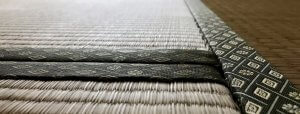
These are made out of the woven fibers of reed, coconut, sisal, jute, and other plants. This option makes for an elegant-looking floor and is easy to install as carpet.
Unlike carpet, which has warp and weft, natural fiber mats are braided. The denser the braid, the tougher the mat will be, but that’s not their main quality.
People generally don’t dye them, because they already have a nice natural color on their own. Their texture is one of their main selling points. That can also change a lot depending on the specific fiber you use and could be soft or coarse.
They’re not very easy to clean, so it’s best to buy ones that have already gotten some kind of anti-stain treatment.
More flexible flooring: cork
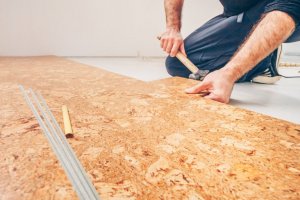
This is a natural material made from the bark of the cork tree. You can get it in sheets or tiles, which you’ll have to varnish after you install them if they haven’t been already.
You can paint yours if you want to, although it does have a nice, natural brown color. Affordable and durable, cork is also good for insulation and soundproofing. This makes it especially good as an option for children’s rooms and places people walk through a lot.
You should clean it with soft soap and make sure to sweep it well beforehand so that you don’t leave it streaked with grit or any other particles.
Vinyl
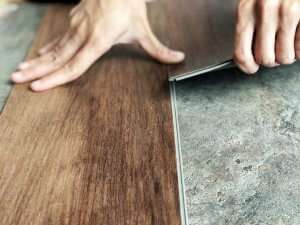
This type is made primarily of PVC and is the cheapest option you’ll find. You can also get it in a lot of different colors and textures, with lots of unique patterns, relieves, or even photographs with a thin, transparent layer to protect them.
If it gets the proper treatments, it’s very moisture resistant and super easy to clean. You just need a neutral soap and a wet mop. Unfortunately, it burns and streaks relatively easily.
Another negative aspect of vinyl flooring is that it can be toxic to inhale if it burns. The PVC in it is also harmful to the environment.
This material ages really poorly, and takes on a worn look that basically forces you to replace it. But because you install it piece-by-piece, you can replace any damaged parts and combine multiple colors, or design borders.
Linoleum
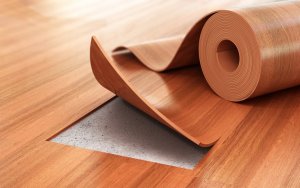
This material looks very similar to vinyl flooring, but it’s higher quality. Like vinyl, you can also get it in a huge variety of color and patterns, which makes it a very modern, eye-catching material.
Linoleum is fireproof, anti-allergic, and anti-slip. You either install it with sheets or tiles. It’s average in terms of durability because it will go rotten if any water filters into it, and hardens over the years.
It’s very common in hospitals because of its antibacterial properties and how easy it is to clean. Ideally, you should use a neutral detergent and wet mop to clean it.
So, do any of these sound like the right flooring for your home remodel? Whether you like one of them or every single one, give it a try! You won’t regret it.
Some of the best aspects of flexible flooring include things like how it’s easy to install, cheap, and can often act as insulation and soundproofing.
But that’s not all. Many of the different types are also moisture resistant and easy to clean. This makes flexible flooring a great choice for places like the kitchen, bedroom, hallways, and anywhere else you spend a lot of time.
Flexible flooring: a safe bet
There are multiple degrees of flexibility within the world of flexible flooring. Textile-based flooring (mats and carpets) and cork are on the softer side. Then there are things like linoleum and vinyl flooring, which are more in the middle.
If you want to avoid spending too much money or want to remodel without having to tear the house apart, these types of flooring tend to be your best option.
They’re easy to install, and often come in rolls, sheets, or tiles. They’re also really easy to clean and maintain in general. In other words, they’re extremely practical and affordable. But best of all: they open up lots of decorative possibilities for you.
Now we’re going to show you some of the best types of flexible flooring. Pay attention, because we’re confident this will help you make a decision.
Carpet

Pleasant to walk on, carpet is very common in colder parts of the world because of its ability to insulate. Another big advantage of it is that it can muffle sounds.
People manufacture carpet out of natural materials like wool or synthetic ones like nylon. But keep in mind that the synthetic ones can often generate static.
As for its disadvantages, it has to be said that carpet flooring isn’t very moisture resistant. It also doesn’t last as long as other types of flexible flooring. You can expect to get about 5-7 years out of yours. The thicker the carpet, the longer it will last.
It’s super easy to install, and you can buy it in rolls or tiles. Carpet tiles are a bit harder to install, but the nice thing about them is that you can’t see the separations between them, and you can replace one if it gets stained or damaged.
Stains are another big disadvantage here. But periodically vacuuming is usually enough to keep it clean. If you really want to keep it looking like new, though, you should do a yearly steam clean.
Mats made of fibers

These are made out of the woven fibers of reed, coconut, sisal, jute, and other plants. This option makes for an elegant-looking floor and is easy to install as carpet.
Unlike carpet, which has warp and weft, natural fiber mats are braided. The denser the braid, the tougher the mat will be, but that’s not their main quality.
People generally don’t dye them, because they already have a nice natural color on their own. Their texture is one of their main selling points. That can also change a lot depending on the specific fiber you use and could be soft or coarse.
They’re not very easy to clean, so it’s best to buy ones that have already gotten some kind of anti-stain treatment.
More flexible flooring: cork

This is a natural material made from the bark of the cork tree. You can get it in sheets or tiles, which you’ll have to varnish after you install them if they haven’t been already.
You can paint yours if you want to, although it does have a nice, natural brown color. Affordable and durable, cork is also good for insulation and soundproofing. This makes it especially good as an option for children’s rooms and places people walk through a lot.
You should clean it with soft soap and make sure to sweep it well beforehand so that you don’t leave it streaked with grit or any other particles.
Vinyl

This type is made primarily of PVC and is the cheapest option you’ll find. You can also get it in a lot of different colors and textures, with lots of unique patterns, relieves, or even photographs with a thin, transparent layer to protect them.
If it gets the proper treatments, it’s very moisture resistant and super easy to clean. You just need a neutral soap and a wet mop. Unfortunately, it burns and streaks relatively easily.
Another negative aspect of vinyl flooring is that it can be toxic to inhale if it burns. The PVC in it is also harmful to the environment.
This material ages really poorly, and takes on a worn look that basically forces you to replace it. But because you install it piece-by-piece, you can replace any damaged parts and combine multiple colors, or design borders.
Linoleum

This material looks very similar to vinyl flooring, but it’s higher quality. Like vinyl, you can also get it in a huge variety of color and patterns, which makes it a very modern, eye-catching material.
Linoleum is fireproof, anti-allergic, and anti-slip. You either install it with sheets or tiles. It’s average in terms of durability because it will go rotten if any water filters into it, and hardens over the years.
It’s very common in hospitals because of its antibacterial properties and how easy it is to clean. Ideally, you should use a neutral detergent and wet mop to clean it.
So, do any of these sound like the right flooring for your home remodel? Whether you like one of them or every single one, give it a try! You won’t regret it.







